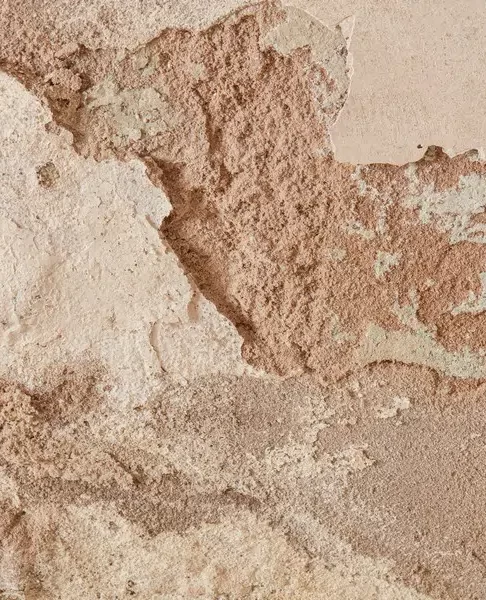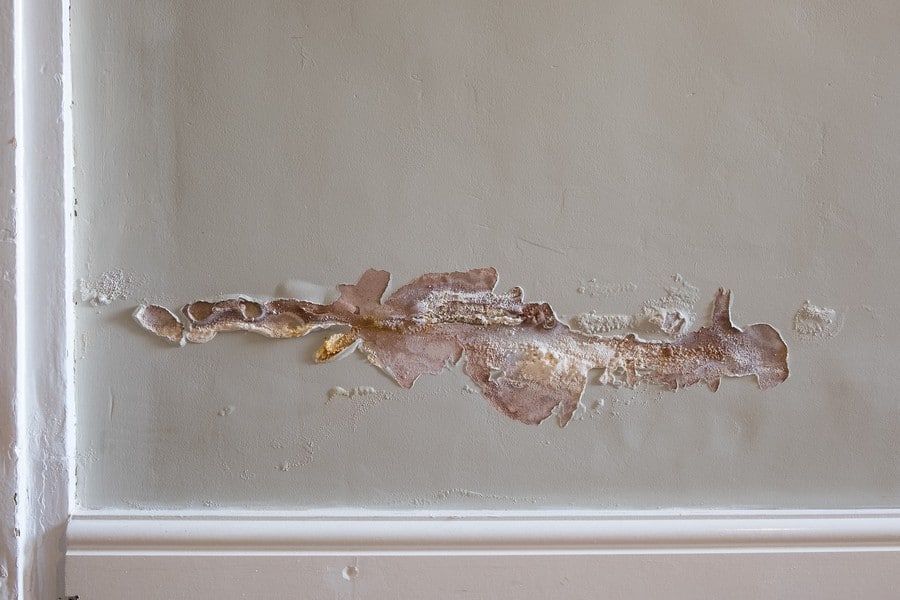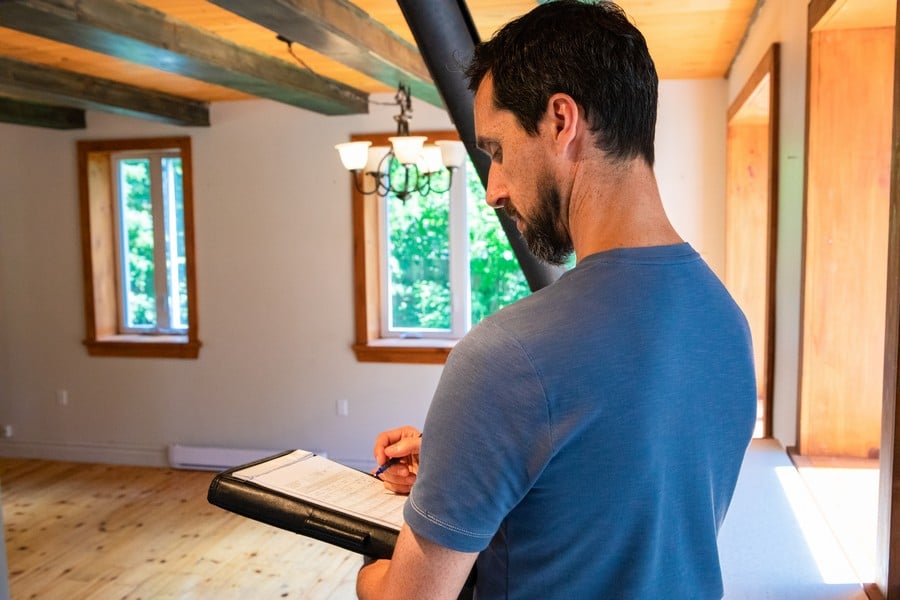Contact Sussex Damp Experts Now to Speak With an Expert.

Rising damp is a phenomenon where water moves upwards through porous building materials in contact with the ground. This occurs due to air drying on upper surfaces, causing walls to act as wicks and draw water up from the ground via capillary action. The moisture will continue to rise until it reaches a point where gravity draws it back down, or evaporation becomes feasible.
Rising moisture in walls can lead to wood rot in surrounding timbers and accumulation of hygroscopic ground salts that dissolve quickly and collect within brickwork and plaster. As such, even when rising damp is addressed, plaster may remain wet or contaminated necessitating its removal.
Unlike penetrating damp caused by rainwater infiltration on top of walls or ceilings, rising damp results from water infiltration below or at ground level. Installing a Damp Proof Course (DPC) effectively prevents rising damp by stopping moisture from moving through floors and walls via capillary action.
The most notable difference between rising and penetrative damp is the height at which they occur. Rising damp is limited to a maximum of one metre above ground level, while penetrating damp can manifest itself anywhere.
Rising damp can be caused by various external factors such as rainwater leaks, inadequate drainage, or faulty plumbing. On the other hand, condensation damp is a result of the humidity in your home from activities like cooking, bathing and breathing. If you suspect that rising damp is affecting your property, it’s best to have a professional assess the situation through a no-obligation site survey. Sussex Damp Treatments offers expert advice and solutions for any type of damp problem you may be facing. Contact them now at 01273 257 212 to speak with an experienced specialist who can provide effective treatments tailored to your specific needs.

Tide marks are left on the wall, one of the most common signs of rising damp. The salt in the earth and its evaporation generate tidal marks. They can be seen up to 1m above the skirting board if you look above it.
Look carefully to see if your wallpaper starts to come away from the skirting board and curls up in the corner.
Keep an eye out near the skirting board if you spot fungus forming or creeping out on the side. Rising damp can destroy timbers and come into contact with various objects, as can other types of dampness. Also, look for loose paint or sections of paint that have been damaged.
Salt in the form of white flaky deposits is another sign. When the salts are washed out of your brick and into the plaster, they appear as blistering patches on your walls.
If you notice black mould growing over your skirting board, it’s a sign that there’s a source of humidity in the area. It could be a warning sign of rising dampness if there is no other evidence of black mould in the home or elsewhere, and the black mould is localised from the skirting board up to 1m above.
To determine if rising damp is the cause of your moisture problem, consider these steps. First, inspect the area in question and run your fingertips along it to feel for any salts that may have risen above ground level. If you have wallpaper, listen for a crunching sound as you do so. Next, examine any exposed brick or stonework and check for signs of dampness or salt formation beneath paint or wallpaper.
Contact Sussex Damp Experts Now to Speak With an Expert.
One of the most common mistakes people make when dealing with damp is mistaking it for condensation. While surface condensation can look similar to damp, there are tell-tale signs that indicate the presence of a problem. To determine if your home has rising damp, taking masonry samples, particularly mortar, can be an excellent way to investigate conditions from beneath the depths of the wall. Evidence of water penetration in these samples indicates rising dampness rather than a condensation problem.
It’s important to note that a Damp Proof Course (DPC) is only effective for treating rising dampness and not condensation. Misapplying this treatment option will not address the issue and may result in using an incorrect solution altogether.
To ensure proper diagnosis and treatment, it’s best to contact qualified professionals like Sussex Damp Treatments who have established themselves as reputable experts in their field. Trusting their expertise will help you address any issues related to damp effectively and efficiently while avoiding costly misdiagnoses or ineffective treatments.
To address any moisture-related issues in your property, the first step is to conduct a thorough inspection. At Sussex Damp Treatments, we prioritise honesty and integrity over profit-making schemes. Our specialists will only report on actual damp problems and provide effective solutions that are both valuable and cost-efficient.
Our team of damp proofing experts can evaluate your property through a comprehensive damp survey approved by the relevant authorities. We offer a wide range of treatments for rising damp, basement waterproofing, dry rot control, timber treatments, and other areas of expertise with 30-year guarantees.

Even with minimal rising damp, there may still be some moisture trapped in the substrate due to salt contamination. To address this issue, Prestige Decorating London offers a chemical DPC system installation that effectively controls the problem. The process involves injecting regular intervals of chemical DPC into the walls and replacing any salt-contaminated plaster. This ensures that the decorative surface is protected from any remaining moisture in the wall, providing long-lasting results for your property’s protection against dampness.
Hygroscopic salts, which have an affinity for water and are present in the soil, can be absorbed by brickwork during periods of high humidity. This results in continued moisture absorption, which can be prevented from rising further with the installation of a damp-proof course. However, if this issue persists to an unsatisfactory degree, re-plastering according to PTL specifications is necessary. Fortunately, PTL has skilled plasterers who are available to provide quotes for this job.
Damp proofing is a crucial method of preventing moisture from entering structures, particularly rising damp. Rising dampness can be identified by yellowish or brownish stains or blown plaster in the bottom section of walls above skirting boards, as well as decaying or moist skirting boards and floors. Minor repairs for rising damp such as repointing or painting over the affected area will only increase long-term costs and require further work later on.
A damp-proof course (DPC) is an effective water-resistant barrier that runs along the length and width of walls to prevent groundwater from creeping up through capillary action. At Sussex Damp Treatments, we offer various choices for damp proofing with unique advantages. A DPC regulates moisture caused by capillary action while a DPM adds a special membrane to combat dampness using silicone material to manage moisture effectively. Cavity wall construction creates space between inner and outer walls to keep water out while pressure grouting plugs gaps in masonry walls providing resistance against water, pressure, and moisture damage.
With a combined experience of over 20 years, our team at Sussex Damp Treatments offers expert damp proofing services in the Sussex area. If you are facing damp issues, contact us on 01273 257 212 to schedule a survey or treatment. Our CSRT and CSSW-trained surveyors will conduct a thorough examination and provide you with a detailed report, price quote, and treatment recommendations based on their findings.
Should you choose to proceed with our services, we have an experienced team of specialists who can handle various types of damp problems such as dry rot and woodworm, wet rot, wood rot, and basement waterproofing solutions for both commercial properties and private homes. We also offer internal dampness control solutions along with rain penetration prevention measures. Our portfolio speaks for itself when it comes to providing comprehensive solutions for all your damp-related concerns. Trust us to deliver quality results that stand the test of time.
Schedule a damp survey appointment or contact us for a consultation, and our team of local experts will promptly arrange to visit your home at your convenience. Our highly trained rising damp investigators possess the necessary skills and experience to efficiently diagnose any issues with your property’s moisture levels.
With years of expertise in the field, we guarantee that you’ll receive top-quality service from our team. Trust us to provide you with an accurate assessment of any potential problems and offer effective solutions tailored specifically to meet your needs. Don’t let dampness ruin the integrity of your home – book an appointment today and let us help you protect it for years to come.

The expenses associated with tackling a damp issue are dependent on various factors, including the size and structure of the property, the root cause of the dampness, and the materials involved. Due to the extensive range of details that need consideration, it is advisable to contact our team of fully trained professionals for a survey.
Our friendly experts will inspect your property thoroughly and gain a complete understanding of your situation before providing you with an accurate quote for repairs and treatments that is cost-effective. Don’t hesitate to reach out to us as we have years of experience in this field and can provide you with expert advice on how best to tackle any damp problem effectively while keeping costs low.
At Sussex Damp Treatments, we pride ourselves on our exceptional standards in damp proofing treatments, professional re-plastering and wood preservation. Our team of experts are highly skilled at performing thorough damp surveys to identify any issues that need addressing. We offer bespoke and reliable services for a range of properties including homes, local authorities, small businesses and large commercial buildings. With years of experience under our belt, you can trust us to provide the highest quality damp proofing treatment and repair services available. Contact us today on **01273 257 212** to speak with one of our friendly team members about your specific needs – we’re always here to help!



Max and his team have been at our property all week and I really can’t thank them enough for the fantastic job they’ve done on plastering both our walls and ceilings. They have literally transformed the appearance of our house! Not only has Ma…
From start to finish Max has been incredable. His knowledge lin damp proofing is second to none and his team where very clean and polite. The plastered finish was like glass so happy we choose Max Plastering for job.
Lovely bunch of lads left a very neat and clean job. Problem was solved.
Perfect Finnish and all left clean and tidy and no mess. Used Max previously and would not hesitate to ask him carry out more work.
Max, Harvey and Stuart arrived promptly as arranged. Done a great job on our outside rear wall. Work completed to a high standard, removal of all old material and cleaned up after themselves. I am so pleased with the standard of their work they ar…
They turned up on time and carried out the works in a very professional manor leaving the front of the house clean and tidy. Very impressed would definitely recommend.
I have to say that on every level Max (with Stuart and Harvey) did an extremely professional job! They explained what they were going to do, they were polite and courteous and respected that they were coming into our home. The plastering is of the…

I called max and he managed to come around the same day to do a survey. The next day I received an extremely detailed survey compared to any other damp proofer which made me feel very at ease that he was going to do the right job. Max and team tur…
Contact Sussex Damp Experts Now to Speak With an Expert.